| | Published September 7th, 2016
| Digging Deep
| | A Short Romp in the Ruth Bancroft Gardens | | By Cynthia Brian | 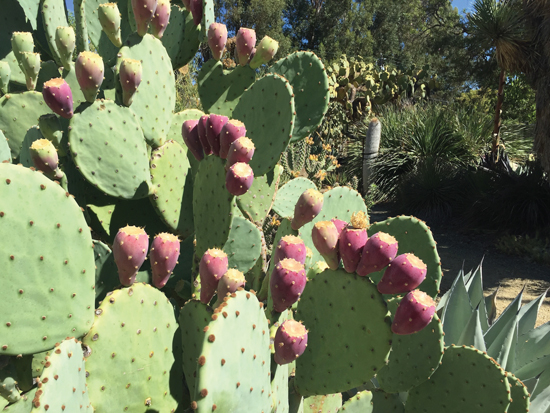 | | This optunia prickly pear cactus in the Ruth Bancroft Garden bears purple tuna fruit ready to be tasted. Photos Cynthia Brian |
Since as long as I can remember I have always said that I wanted to live to be 108 years old. Why I chose that number I have no idea as I had never met anyone who lived to be 108...until this week when I met Ruth Bancroft, creator of the Ruth Bancroft Gardens in Walnut Creek. Ruth turned 108 years young on Sept. 2 and I was privileged enough to celebrate her birthday with bubbly and her favorite chocolate cake in her masterpiece dry gardens that she began planting in the 1970s.
 Bancroft's gardening passion began as a child in Berkeley. When she moved through the tunnel to Walnut Creek she became a "collector." Her efforts, trials, tribulations and experiences along the way are chronicled in the new Timber Press book, "The Bold Dry Garden," penned by Johanna Silver, the garden editor of Sunset magazine, and photographed by Marion Brenner. With the entire West Coast on drought alert, the Ruth Bancroft Gardens are a model for low-water plantscaping. If you have ever been curious about succulents, cacti, yuccas, and other desert plants that will flourish in the East Bay, this beautiful book will become an essential reference guide.
Bancroft's gardening passion began as a child in Berkeley. When she moved through the tunnel to Walnut Creek she became a "collector." Her efforts, trials, tribulations and experiences along the way are chronicled in the new Timber Press book, "The Bold Dry Garden," penned by Johanna Silver, the garden editor of Sunset magazine, and photographed by Marion Brenner. With the entire West Coast on drought alert, the Ruth Bancroft Gardens are a model for low-water plantscaping. If you have ever been curious about succulents, cacti, yuccas, and other desert plants that will flourish in the East Bay, this beautiful book will become an essential reference guide.
 Our local water company states that water use was 24 percent less in 2015 than it was in 2014, saving enough water to fill the Oakland Coliseum 71 times! As homeowners rip out lawns in favor of xeriscaping, we'll focus on the benefits of adding low maintenance, low water use plants and planting them NOW in your garden.
Our local water company states that water use was 24 percent less in 2015 than it was in 2014, saving enough water to fill the Oakland Coliseum 71 times! As homeowners rip out lawns in favor of xeriscaping, we'll focus on the benefits of adding low maintenance, low water use plants and planting them NOW in your garden.
 Although I have a lifetime of gardening experience, I'm not sure that I will ever become an expert in any one area of horticulture, as gardens are living, breathing, evolving, growing entities that are constantly changing. What I adore about Bancroft's garden is this consistent evolution. Each time I visit, a new vista or display greets me, even from the same specimens as the first visit. The colors, textures and sizes are in perpetual motion, from California natives to the canopy of trees, the rosettes of terrestrial bromeliads to the swords of the yuccas.
Although I have a lifetime of gardening experience, I'm not sure that I will ever become an expert in any one area of horticulture, as gardens are living, breathing, evolving, growing entities that are constantly changing. What I adore about Bancroft's garden is this consistent evolution. Each time I visit, a new vista or display greets me, even from the same specimens as the first visit. The colors, textures and sizes are in perpetual motion, from California natives to the canopy of trees, the rosettes of terrestrial bromeliads to the swords of the yuccas.
 Here are a few of Bancroft's prized collection that you can grow in your garden for your benefit and that of your great-grandchildren's children.
Here are a few of Bancroft's prized collection that you can grow in your garden for your benefit and that of your great-grandchildren's children.
 Aeoniums: One of the most popular plants of all of the succulents, aeoniums have lovely fleshy rosettes that will reach towards the heavens, mound in purgatory or cascade towards hell. They prefer a bit of shade and are easy to cultivate and grow in the ground and in containers.
Aeoniums: One of the most popular plants of all of the succulents, aeoniums have lovely fleshy rosettes that will reach towards the heavens, mound in purgatory or cascade towards hell. They prefer a bit of shade and are easy to cultivate and grow in the ground and in containers.
 Yuccas: These sword-shaped plants are native to the Americas and the Caribbean and like hot, dry regions. In their natural habitat they are pollinated by the yucca moth. Although yuccas are grown mostly for ornamental use, many species use the seeds, flowers, stems and sometimes the roots for food and medicine.
Yuccas: These sword-shaped plants are native to the Americas and the Caribbean and like hot, dry regions. In their natural habitat they are pollinated by the yucca moth. Although yuccas are grown mostly for ornamental use, many species use the seeds, flowers, stems and sometimes the roots for food and medicine.
 Echeveria: Many of the most beautiful small succulents are echeveria, often confused with aeoniums because of their rosettes. Their leaf colors are brilliantly hued and they boast flowers in red, orange, white, yellow, purple, and pink. They grow well between rocks and are a terrific ground cover or garden filler. Most echeveria species hail from Mexico.
Echeveria: Many of the most beautiful small succulents are echeveria, often confused with aeoniums because of their rosettes. Their leaf colors are brilliantly hued and they boast flowers in red, orange, white, yellow, purple, and pink. They grow well between rocks and are a terrific ground cover or garden filler. Most echeveria species hail from Mexico.
 Sedums: A hardy perennial with thick, fleshy leaves and stems and clusters of pretty flowers, sedums are most popular for groundcovers, borders and rock gardens. They require minimal to no care at all, are easy to propagate from cuttings, and are drought resistant.
Sedums: A hardy perennial with thick, fleshy leaves and stems and clusters of pretty flowers, sedums are most popular for groundcovers, borders and rock gardens. They require minimal to no care at all, are easy to propagate from cuttings, and are drought resistant.
 Aloe: The best-friend plant for anyone with a sunburn, cut or bite, aloe is known as nature's soothing succulent. Aloes relieve itching and irritation on the skin, and reduces redness and swelling by inhibiting the body's release of histamine. In a garden, aloes bloom in bright colors of red, orange and yellow with over 500 species ranging from tiny to tree height. These unfussy favorites are a "must have" in any garden or container.
Aloe: The best-friend plant for anyone with a sunburn, cut or bite, aloe is known as nature's soothing succulent. Aloes relieve itching and irritation on the skin, and reduces redness and swelling by inhibiting the body's release of histamine. In a garden, aloes bloom in bright colors of red, orange and yellow with over 500 species ranging from tiny to tree height. These unfussy favorites are a "must have" in any garden or container.
 Agave: With over 200 species native to the Americas, agaves are diverse in colors, shapes, sizes, and spines. Agaves are sculptural. They can be a focal point in a landscape or can mix well with other plantings. Before planting an agave, make sure to read the label to determine the final size of the plant. Some agaves have a full-grown diameter of 13 to 14 feet while others remain small and compact.
Agave: With over 200 species native to the Americas, agaves are diverse in colors, shapes, sizes, and spines. Agaves are sculptural. They can be a focal point in a landscape or can mix well with other plantings. Before planting an agave, make sure to read the label to determine the final size of the plant. Some agaves have a full-grown diameter of 13 to 14 feet while others remain small and compact.
 Barrel Cactus: Always armed with heavy spines and prominent ribs, barrel cacti are known as the "fierce or wild cactus." Flowers always grow at the top without spines. Native Americans boiled the flowers to eat like cabbage. The fruits are considered inedible. Barrel cacti add a fascinating form to any landscape when planted in circles or artistic ways.
Barrel Cactus: Always armed with heavy spines and prominent ribs, barrel cacti are known as the "fierce or wild cactus." Flowers always grow at the top without spines. Native Americans boiled the flowers to eat like cabbage. The fruits are considered inedible. Barrel cacti add a fascinating form to any landscape when planted in circles or artistic ways.
 Prickly Pear Cactus: Optunias, commonly called prickly pear cactus, have yellow, red, purple or orange fruit that is delicious and sold in stores as tuna. The paddles are called Nopales and used in many ethnic recipes. The soluble fibers of both the fruit and the paddles are considered to stabilize blood sugar. These cacti make a great fence to keep out human and animal invaders as the spines are tiny and very sharp. My sister surrounded her property with optunias that bore enough fruit for a weekly farmer's market booth.
Prickly Pear Cactus: Optunias, commonly called prickly pear cactus, have yellow, red, purple or orange fruit that is delicious and sold in stores as tuna. The paddles are called Nopales and used in many ethnic recipes. The soluble fibers of both the fruit and the paddles are considered to stabilize blood sugar. These cacti make a great fence to keep out human and animal invaders as the spines are tiny and very sharp. My sister surrounded her property with optunias that bore enough fruit for a weekly farmer's market booth.
 Although I've concentrated on the desert plants, the Ruth Bancroft Garden reveals a softer side with riffs of bulbs, wildflowers, grasses and California natives. A visit to the Ruth Bancroft Garden is a must-do for anyone interested in learning more about dry and drought tolerant gardening. We are fortunate to have one of the nation's most renowned public gardens literally in our backyard with a collection of rare specimens available for sale that will enhance your landscape while saving precious water. Visit www.RuthBancroftGarden.org for more information.
Although I've concentrated on the desert plants, the Ruth Bancroft Garden reveals a softer side with riffs of bulbs, wildflowers, grasses and California natives. A visit to the Ruth Bancroft Garden is a must-do for anyone interested in learning more about dry and drought tolerant gardening. We are fortunate to have one of the nation's most renowned public gardens literally in our backyard with a collection of rare specimens available for sale that will enhance your landscape while saving precious water. Visit www.RuthBancroftGarden.org for more information.
 Embrace your sense of curiosity. Employ a few of Ruth Bancroft's dry gardening specimens. Gardens are a legacy to our future and the time to plant is today. In 108 years, who will be enjoying your garden?
Embrace your sense of curiosity. Employ a few of Ruth Bancroft's dry gardening specimens. Gardens are a legacy to our future and the time to plant is today. In 108 years, who will be enjoying your garden?

 Happy Gardening and Happy Growing!
Happy Gardening and Happy Growing!

|
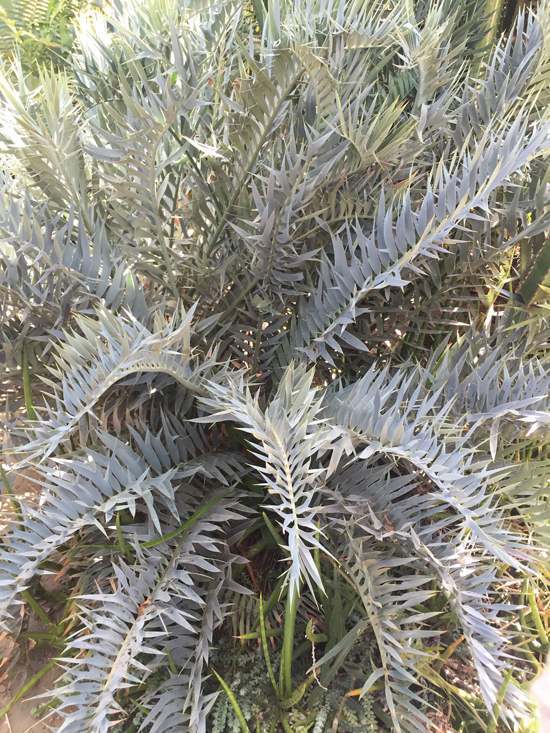 | | Encephalartos horridus was Ruth Bancroft's first cycad-very prickly and scary plant. | 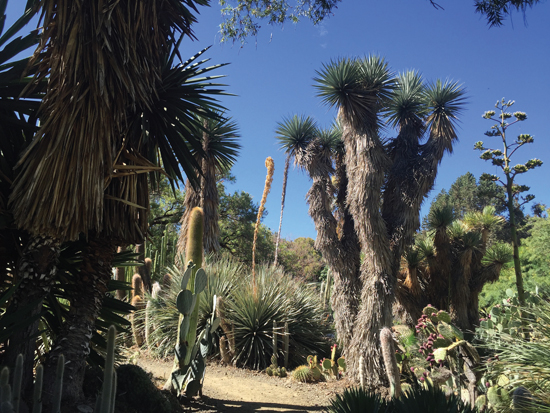 | | These full-grown yuccas frame the desert-like environment in this area of Ruth Bancroft's garden. | 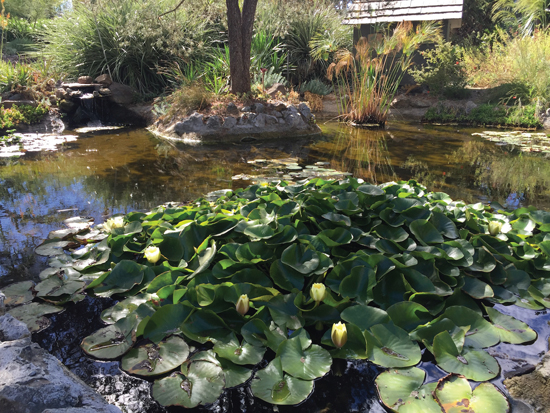 | | The pond is restorative and soothing. |  | | This aqua blue aeonium is stunning in a vintage Mexican bowl. | 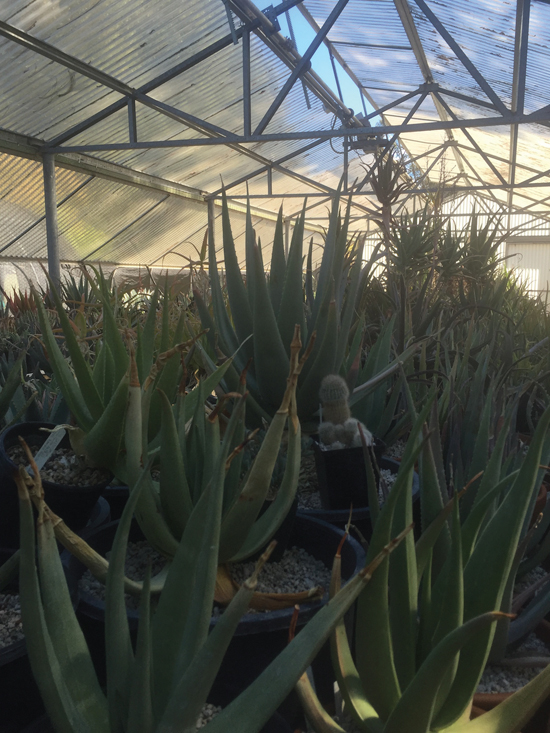 | | A world renowned succulent expert, Brian Kemble breeds South African aloes seeking the bumpiest and bluest in the Ruth Bancroft propagation greenhouse. A variety of succulents including aloes boast the colors of autumn. Photo Cynthia Brian Ruth Bancroft, 108 years old, and Cynthia Brian at her birthday celebration. (c)2016 Cynthia Brian The Goddess Gardener Starstyle(r) Productions, llc Cynthia@GoddessGardener.com www.GoddessGardener.com 925-377-STAR Tune into Cynthia's Radio show at www.StarStyleRadio.net I am available as a speaker, designer, and consultant. | | | |










